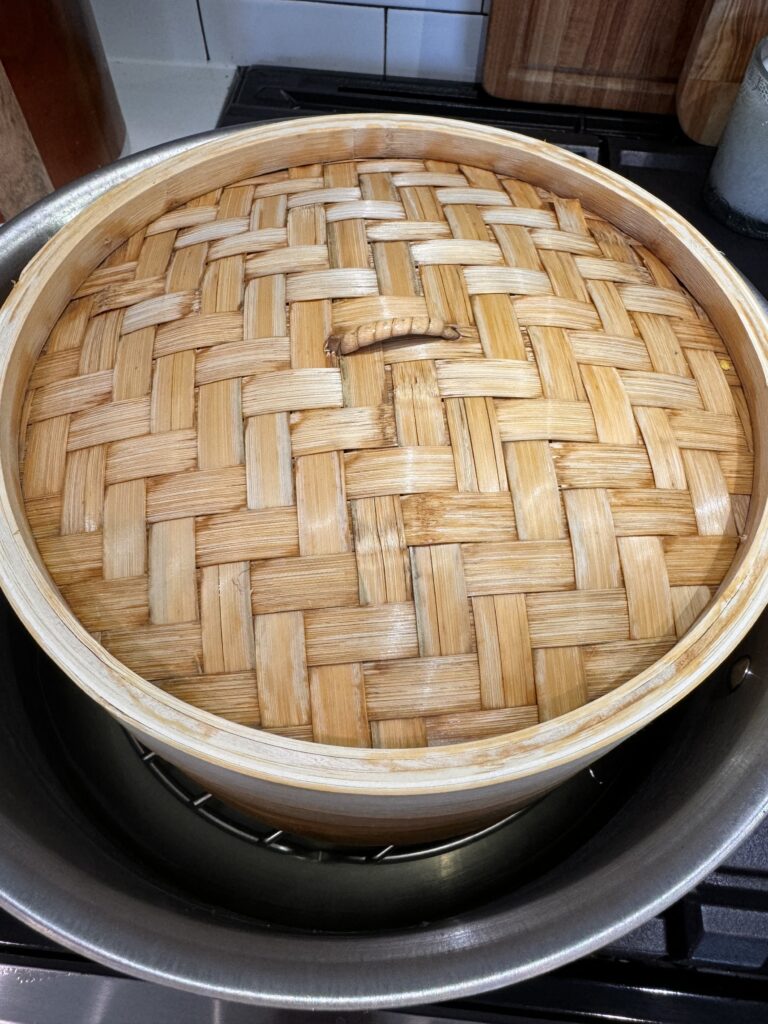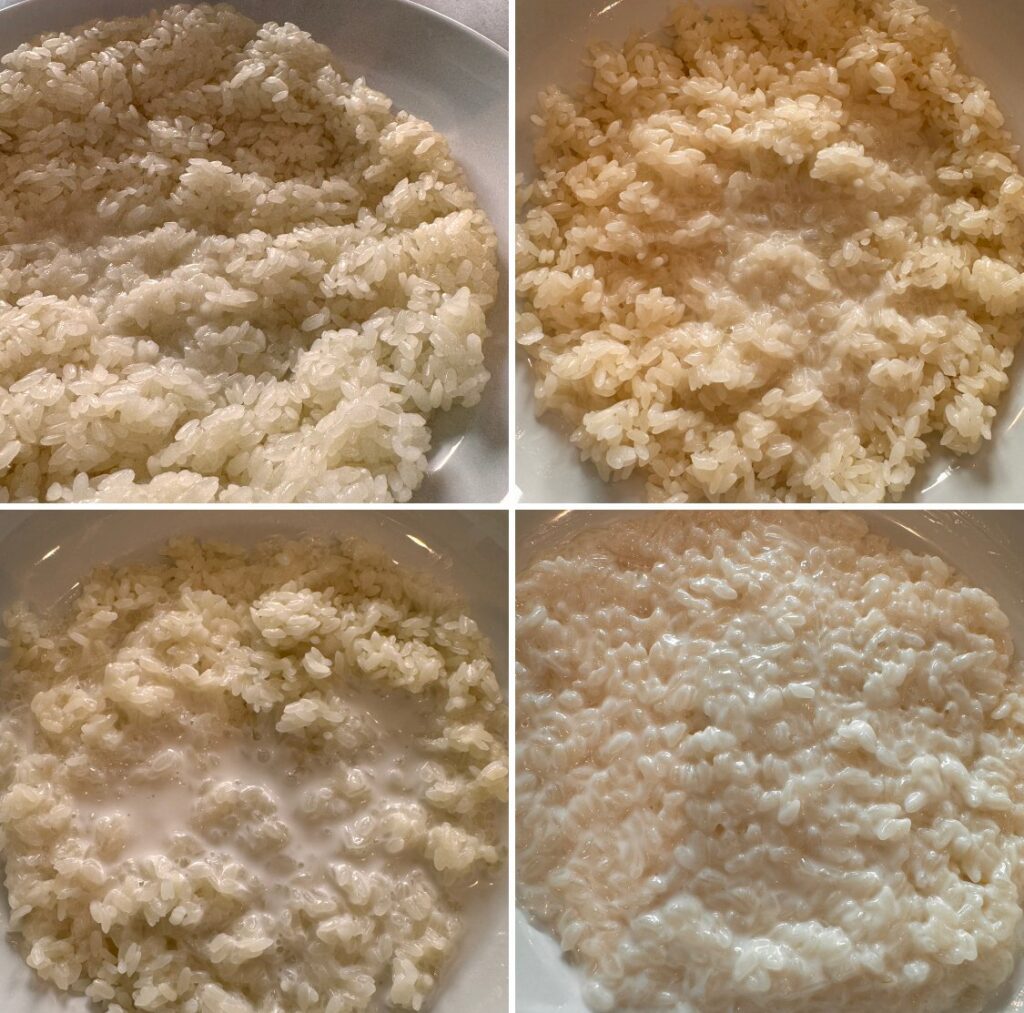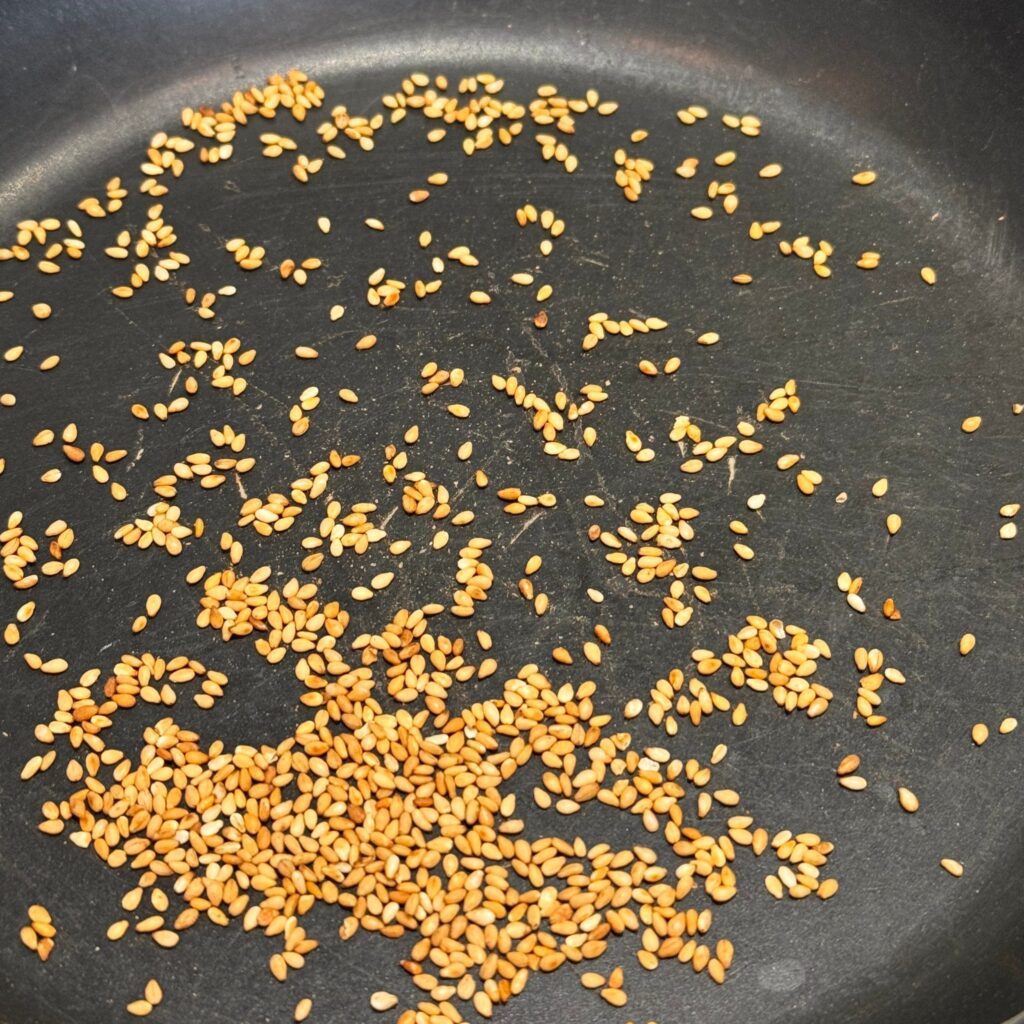WHERE DID MANGO STICKY RICE COME FROM?
It’s not clear where mango sticky rice originated. Although it is one of Thailand’s favorite and most popular desserts, neither mango nor sticky rice originated in Thailand. Mangoes were first grown in India for over 5,000 years and also indigenous to Burma and eastern Asia. Sticky rice has its origin in Northeastern, or Isaan, part of Thailand bordering Laos.
This was also a common dish for the Laos people of the Greater Mekong Sub-region, where sticky rice has been cultivated throughout the history of its culture, food, and tradition. As a result, it’s most likely the by-product of many different cultures in the region throughout time.
Many historians have traced the dish back to the 14th century dating back to the late Ayutthaya period (1351-1767). It continued into the reign of King Rama II. The King stated that khao niew moon (steamed sticky rice with coconut milk) were to be eaten with fruits, presumably sweet mango.

THE COMPONENTS
You will only need a few ingredients to make mango sticky rice. The two main ingredients are glutinous rice and ripe mangos. Coconut milk will be used to make the sauce for the rice to soak in and also as a topping.
Glutinous Rice
Sticky rice, also called glutinous rice or sweet rice is a gluten-free rice used throughout Asia. When cooked, they are semi-opaque and have a sticky texture. The reason for the stickiness is the absense of of starch amylose, which makes the rice sticky. It comes in long-grain and short-grain and can be used in sweet and savory dishes. It is most often steamed or boiled, but it can also be used in stir-fried or cooked like Italian risotto.
Sticky rice is called “sweet rice” because it is slightly sweet. It is sweeter than regular white rice, which is why it works so well in desserts, but by no means is it confined to desserts. The Japanese steam sticky rice and serve it topped with sesame seeds.; the Vietnamese cover it with soybean sauce to eat with pork. Indonesians eat it with chicken wrapped in banana leaves.

Before cooking sticky rice, it should be soaked in tepid water to soften the tough outer shell and ensure the rice will be cooked throughout. You can also let it sit in cold water for an hour after washing and rinsing 3-4 times. I recommend soaking your rice overnight for the best result.
To cook the rice, place the rice in the cooking pot and cover with water. A typical ratio is 2 cups of rice to 3 1/2 cups of water. Leave to soak, add 3/4 teaspoon of salt, and then steam the rice either on the stovetop or in a bamboo steamer.
To steam on the stovetop, allow the water and rice to come to a boil and then reduce the heat to a simmer. Cover partially with a lid and simmer for 10 minutes. If the water has not been absorbed, steam for an additional 5-10 minutes. Place the lid on the pot and let sit for 10 minutes to continue cooking.
To cook in a bamboo steamer, drain the soaked rice, place it in the steamer, cover, and steam over high heat for 30-45 minutes, until the rice is soft and translucent. My favorite brand is Sho-Chiku-Bai and is a product from Koda Farms in California.

Some tips for cooking sticky rice:
- line your bamboo steamer with a damp cheesecloth, place the soaked rice on top, and fold the edges to cover the rice
- don’t add too much water to your pot when steaming. You want enough water to come up 0.5-1 inch above the rice. You do not want the water to touch the rice when boiling
- if the rice is undercooked and has an opaque center but is crunchy in the middle, your rice does not absorb enough water, and steam for longer will not fix this. Remove the steamer basket from the heat and pour cold water over the rice, stirring so that the additional water coats every grain. Then put it back on the steamer and steam it for 10-15 minutes
- you can also use your rice cooker to cook sticky rice if your rice cooker has a “sweet rice” function. You will need to wash the rice as usual, and then use a ration of 1 part water to 1.5 parts rice to cook
- if your rice is sticking to the bamboo steamer, you need to soak the basket in water first. If you are using a steamer rack, you need to wet the cloth that you line the steamer. Rice that comes into contact with dry surfaces will cause the rice to stick.
Mango
Two types of mangoes pair well with coconut sticky rice: OK-Rong and Nam-Dokmai. You can however, pair other types with coconut sticky rice, but the result would be more authentic with the above mentioned mangoes. In the US, the closest thing to OK-Rong and Nam-Dokmai is the Manila or Ataulfo mangoes. Ataulfo mangoes are meaty, non-fibrous, fragrant, and very sweet, making it a perfect choice for sticky rice.

Larger Tommy Atkins mangoes work well too. If you don’t have access to these mangoes, you can also use yellow or champagne mangoes as they tend to be sweet as well. If you can’t find any of these, then any mangoes will do, but I would recommend the above mangoes first if you can get them.
The key here is to use ripe mangoes. If your mangoes are still tough, simply store them at room temperature to ripen. Once the mango gets soft, place it in the refrigerator so it will stay fresh until you use it. When serving, make sure your mango is cold. The contrast between the cold mango and warm rice is just purely delightful!

Canned Coconut Milk
For this recipe, use full-fat canned coconut milk for the creamiest sticky rice. My favorite brands is Chaokoh as it has a smooth, creamy taste with zero lumps. You can use full-fat coconut milk or light coconut milk for a low-fat version. It will be less creamy, but it will still be delicious. You can also opt for coconut cream, but this is higher in fat but will be more creamier.

Sugar
Sugar is added to the coconut sauce while cooking the rice as well as the coconut topping sauce to add before serving. You can adjust the sugar content if you want less sweet or more sweet. If you want to completely omit refined sugar, using Medjool Dates is a good option. To do this, follow the recipe but omit the sugar when making the coconut sauce with the dates. Blend all ingredients in a high-speed blender and continue with the recipe as normal. You can also use this to make the topping on the sticky rice.
You can also omit the sugar altogether and replace it with Eryhritol and Xylitol. Coconut sugar, date sugar, or maple syrup can also be used.
Salt
Salt is a key component as it brings out the flavor of the rice. It is added to the rice and the topping.
Sesame Seeds (optional)
This is optional, but it does add a wonderful nutty flavor and texture to the dessert.
Tapioca Starch
This is used to thicken the coconut cream sauce. Cornstarch can also be used if you do not have tapioca starch.
Equipment Needed
Cheesecloth or Muslin cloth—this is used to prevent the grains of rice from falling through the holes and allows for even cooking
bamboo steamer— the best way to cook sticky rice is to steam it. This is the method used in Thailand and yields the fluffiest rice with the best texture. In Thailand, rice is steamed in a special woven basket made from bamboo. You can replicate this method at home by using a damp cheesecloth over the steamer basket.

VARIATIONS OF MANGO STICKY RICE
UBE STICKY MANGO RICE
You can use ube in this recipe to create a merging of two cultures- Thai and Filipino. Ube is a purple potato that is used in a lot of Filipino cuisine. It has a vanilla, nutty flavor compared to other sweet potatoes. You can usually find grated ube in the frozen section of your Asian markets or use ube powder. Ube extract can also be used.
The Foodie Takes Flight has a great version of this recipe where she ube to the coconut rice.
PANDAN MANGO STICKY RICE
Pandan is a herbaceous tropical plant that is grown in Southeast Asia. It is similar to a palm where the leaves are bright green, long, slender, and spiky. The leaves are used in many Thai and Southeast Asian dishes. It is sold in its leaf form, as a paste, extract, or powder, and used in many dessert dishes.
Pandan has a sweet aroma that is often described as floral, grassy, and nutty. The taste of pandan is subtle and can be difficult to pinpoint, but it is often compared to a combination of vanilla, coconut, and almond flavors with a hint of grassiness.
To add pandan to your mango sticky rice, just add pandan extract to your coconut sauce. Alternatively, if you have fresh pandan leaves, add the leaves to a blender with enough water and blend for about 2 minutes. Strain the juice and add to your coconut sauce.
ALTERNATIVE TO MANGO
If for some reason, you are allergic to mango or do not like the fruit, you can substitute other fruits for the recipe. Some options are papaya, peaches, pineapple, bananas, and jackfruit. If you are more on the adventurous side, durians are a great option too!

HOW TO STORE
The best way to enjoy mango sticky rice is to eat it within 1-2 days, but if you do need to make it ahead, make sure you store the rice, coconut sauce, and the mango separately. I recommend not cutting the mango until you serve it as well. Before serving, microwave or steam the rice until warmed and softened. Store the sticky rice at room temperature, covered with a plastic wrap to avoid altering the texture of the rice. The rice can be stored at room temperature for 12 hours, or 24 hours refrigerated.
THE RECIPE
This mango sticky rice recipe is a tropical treat for hot Summer days. The contrasting flavor of the tart but sweet mango is a lovely combination with the sticky sweet rice. The salt added balances the sweetness and enhances the coconut taste.

This Mango Sticky Rice recipe is easy to make. I highly suggest reading tips on how to cook sticky rice. Also, you will need one can of coconut milk for the entire recipe. Here’s how to make Mango Sticky Rice:
WHAT YOU WILL NEED:
For the Sticky Rice
- 1 cup glutinous rice (sticky rice or sweet rice)
- 1 cup full-fat coconut milk or coconut cream
- 3 tablespoon sugar
- 1/2 teaspoon salt
- 1-2 large ripe mangoes
For the Coconut Sauce
- 1/2 cup full-fat coconut milk
- 3 teaspoon sugar
- 1/4 teaspoon salt
- 1 teaspoon tapioca starch
- 1 teaspoon white sesame seeds
Prepare the Rice
Step 1:
Wash the rice 3-4 times to remove the starch or until the water is almost clear. Soak the rice in a generous amount of water overnight or for at least 4 hours before cooking.

Step 2:
Drain the rice and rinse well. Place the rice in a piece of cheesecloth. Lay the rice in your bamboo steamer and fold the cheesecloth over to cover the rice.

Step 3:
Add water to your steamer but not too much. You want enough water to come up 0.5-1 inch above the rice. You do not want the water to touch the rice when boiling. Allow the water to come to a boil, then reduce heat to simmer. Steam the rice for 20 minutes. When cooked, it should be soft, sticky, and translucent. If it is still dry or hard, continue steaming until it is cooked. Make the coconut sauce while the rice is steaming.


Step 4:
In a small saucepan, add 1 cup of coconut milk or coconut cream, 3 tablespoons of sugar, and 1/2 teaspoon of salt. Heat on medium until the sugar is dissolved, making sure it does not come to a boil. Set aside.
Step 5:
When the rice is done, remove it and place the rice in a shallow bowl, spreading it around the bowl with a rubber spatula. Make sure not to flatten it like a pancake, but use the spatula to make pockets. This is where the coconut sauce will go.


Step 6:
Add the coconut sauce to the rice, adding a small amount first. Allow it to soak up the rice, adding more as it soaks. You want the rice to soak up the liquid, but not get too wet. Continue adding the sauce to the rice, allowing it to soak, but ensuring the rice does not get soggy. Let the rice sit for 20 minutes while you make the topping.
Make the Topping
Step 1:
In a small saucepan over low heat, add 1/2 cup of coconut milk, 1/4 teaspoon salt, and 3 teaspoons sugar and dissolve. When sugar is dissolved, add add 1 teaspoon of water to the starch and mix, making sure there are no lumps. Add the starch mixture to the pot. Stir well and continue to cook on low until the sauce thickens. Pour the topping into a small bowl and cool in the refrigerator.

Step 2:
While that cools, toast the sesame seeds in a pan on medium-low heat for a minute until golden brown. Shaking the pan to prevent burning. This should take no more than 2-3 minutes.


Plate the Mango Sticky Rice
Peel and cut the mango, creating 4 mango halves. Slice each piece into 1/4 inch thick strips. One large mango is enough for 2 servings. Put half the sweetened rice on a plate (rice should be warm). Lay the cold mango next to it. Sprinkle with toasted sesame seed. Drizzle the cold sauce over it and enjoy!

✅ Quick Tips: Read the recipe in its entirety before you start cooking. This will help you understand the ingredients, steps, and timing involved, and allow you to prepare any necessary equipment or ingredients beforehand.

Mango Sticky Rice
Ingredients
For the Sticky Rice
For the Coconut Sauce
Nutritional Value
Nutritional Value
Servings 6
- Amount Per Serving
- Calories 299kcal
- % Daily Value *
- Total Fat 13g20%
- Saturated Fat 11g56%
- Sodium 300mg13%
- Potassium 278mg8%
- Total Carbohydrate 45g15%
- Dietary Fiber 2g8%
- Sugars 17g
- Protein 4g8%
- Calcium 30 mg
- Iron 2 mg
* Percent Daily Values are based on a 2,000 calorie diet. Your daily value may be higher or lower depending on your calorie needs.










